Part Five: Personal Development
Project: Different ways of applying paint
I started the project from impasto using a think paint brush and acrylic paint, I tried to paint placing a thick amount of paint onto the page experimenting how the paint combines with other colours on paper. For this exercise I found an easy composition of fruit and a bouquet of flowers. I tried to not pay attention to detail; I just wanted to create an effect using a thick layer of paint.
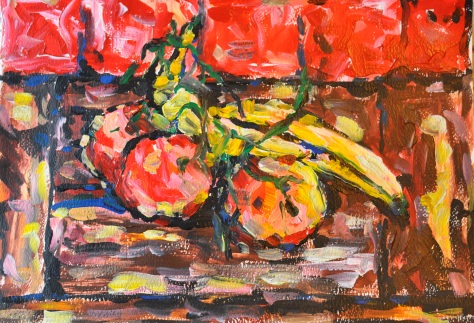
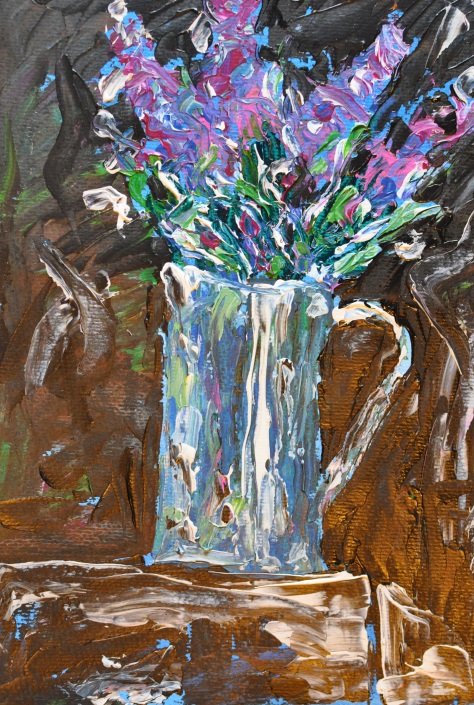
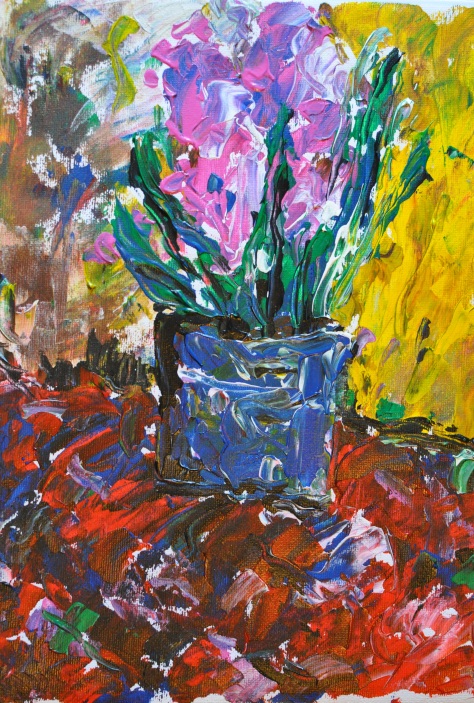
Next I decided that to get a good impasto effect I needed to buy some more equipment and got a matt impasto gel for acrylics and a heavy structure gel also for acrylics. I started painting using a painting knife and a rubber scratching pencil alongside a normal brush to create the desired effect. Before I started using every element I needed to decide what to paint and was not going to carry on with still life but try to paint a simple landscape, I chose a few photographs which I could use for the project and after a moment of consideration I came to the conclusion I couldn’t put as much detail into the picture as there was in the photograph. Using impasto gel it was easiest to use the painting knife and this means not putting in as much detail. I didn’t pay too much attention to the kind of landscape I just wanted to try out the technique using the photograph as a stencil. I painted picture with pine trees in the front to give the picture some sense of space with something in the foreground and background.
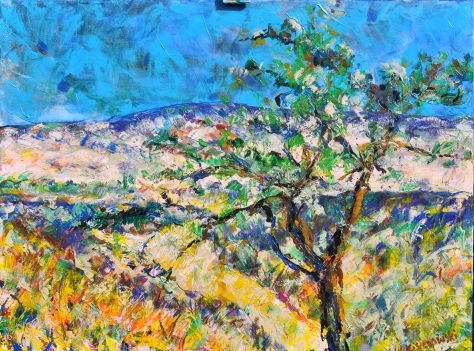
Next I decided to change my palette of colours and play with a different landscape with a similar composition featuring a tree in the forefront and hills covered in snow in the background. When I applied mixed gel with acrylic with the knife I also used a paintbrush to go over some detail.
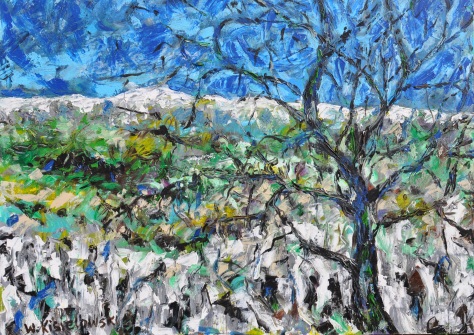
I next wanted to come back to a painting I have shown earlier and see how I can build a similar picture to one I have done already but using the impasto technique, it was of course simplified and details were missed out so I could use the technique.
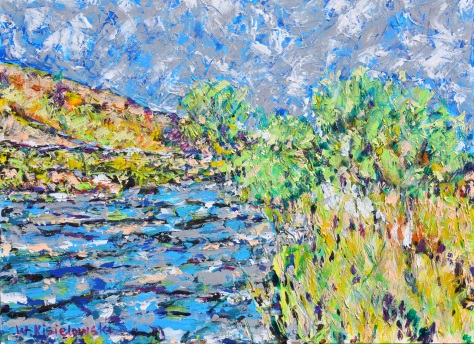
After finishing the painting I decided that the technique is very difficult and I needed to paint a picture where the forefront was simpler and calmer but the concentrate on the details of branches, I always found painting trees a difficulty so this was a little challenge for me. I didn’t want to pay attention to each leaf or branch but I wanted to show an impression that the trees are three dimensional and fit into the space.
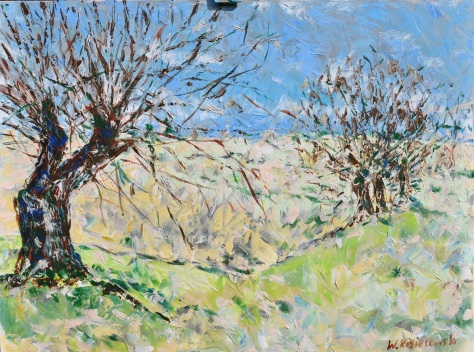
I now continued the tree theme using a painting knife but working more expressively and I also applied paint using a paintbrush dripping and almost throwing it onto the canvas. I had a few layers of paint with impasto gel and used a scratching method for further detail.
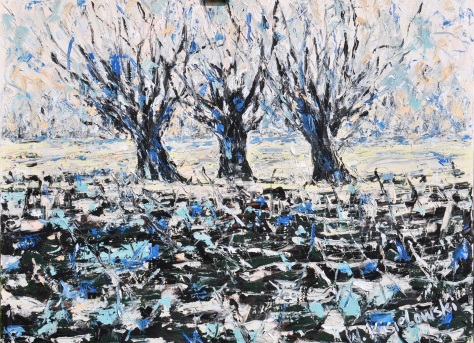
After finishing this picture I started to think about the main project and decided that the technique and process would be useful for the final piece. I used a photograph of willows near a lake, covered in grass and weeds. They are very fascinating trees with large roots coming out the ground and lots of branches. I used a similar pallet of colours to the previous painting and used the same technique.
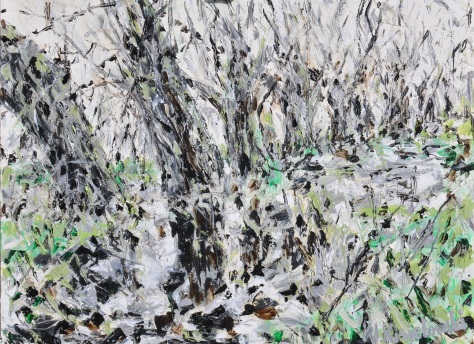
Project: Adding other Materials
I prepared two small A3 canvased covering them with toilet paper and pva glue, creating a texture. When I was applying the wet paper I didn’t really think about what I was going to create and when the canvas dried I had a dilemma of what to do with it. I tried to cover it with paint and seeing what it comes out as; I added a little impasto gel to give even more texture. After finishing with light shades I decided to add some bring darker colours. I decided that it resembled a blossoming tree. Next I decided that using heavy structure gel and acrylic I would add rice to the paint. I tried to see how the method could work and paint a abstract looking nightly landscape with a tree in the foreground. The two exercises were interesting and showed that I can add structure, texture and relief to my painting which in turn created a deeper space not using just paint which is expensive. The painting was a typical experiment and also piece of work with many luck accidents as the form of composition was created by the moving rice as it didn’t completely stay in place.


The next experiment was the final piece where I added hair from natural hair from brushes.
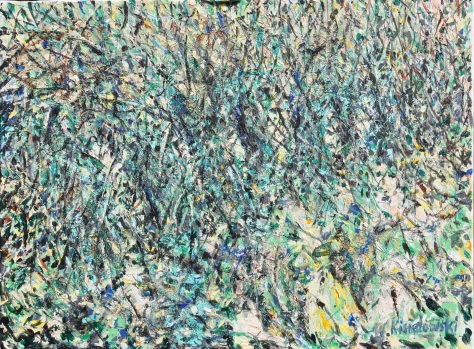
Project: Towards Abstraction
I started this project with but wasn’t completely convinced towards as the exercised don’t fit with my nature. I am not a painter who tends towards abstracts. Creating abstract painting is a natural process which lives inside an artist whereas I need to mature towards an abstract painting. I need to find a more natural way of creating abstract paintings. I thought for a long time about what to create and started with a simple form of a tulip and came to the barrier that for it to be abstract it needs to be painted in a different technique to what I paint. I did sketches using water colour and next on canvas I tried to create a water colour effect without having any idea of how to expand it into something abstract, I decided that I could express it as a tulip but some natural plant form. Next I decided that I would take the structure of the flower and paint it using patches and create a relief around it.
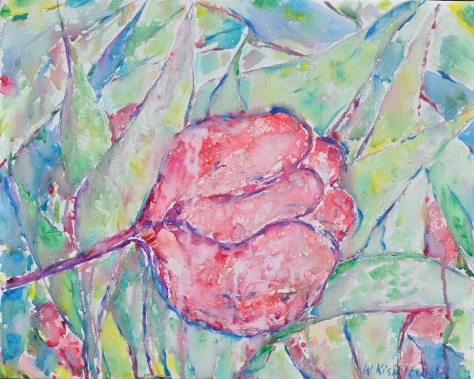
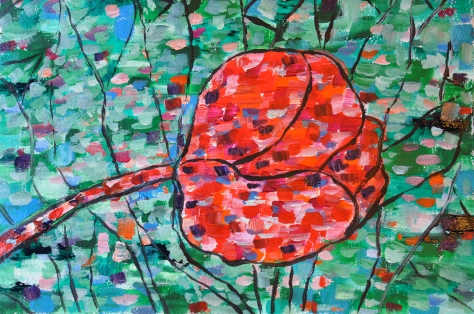 I got the same problem with man-made forms. I chose simple objects like a brush on a table covered with a blue sheet covered in paint marks. I tried to arrange a few simple compositions so that I wasn’t paying attention to the detail of the brushes but to show them as objects in space, this was my only idea of showing an abstract illusion.
I got the same problem with man-made forms. I chose simple objects like a brush on a table covered with a blue sheet covered in paint marks. I tried to arrange a few simple compositions so that I wasn’t paying attention to the detail of the brushes but to show them as objects in space, this was my only idea of showing an abstract illusion.
I was already working on my final piece at the same time and decided to try showing the willows in a more abstract way using unnatural red and blue colours.
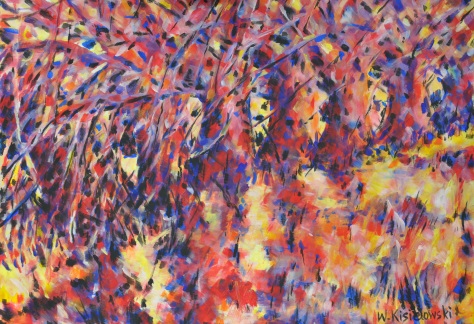
“The Challenge Of Landscape Painting” by Ian Simpson

This book is a guide to help painters look at landscapes in a new and personal way and translate this into a successful landscape painting. It looks at the challenges faced by those wanting to paint a landscape and why many artists are fascinated by them. The book discusses differences between painting on the spot, using a photograph and painting from memory and each advantage and disadvantage each method has, going in depth into each method. The thing I found most interesting was the illustrated interviews with many artists for example John Piper and Norman Adams. They talk about their experience in a very personal way, teaching us how they solve different issues they face and what they find most fascinating about painting landscapes.
The book isn’t aimed at a certain type of artist as I feel like it offers advice that anyone at any level could find useful and this is why I found myself looking into the book throughout the project. I found it particularly interesting that the book doesn’t specify a certain method of painting but encourages you to try out different things and experiment with what you personally feel is a good idea. This book is good for self development as it shows each artist has its own unique character and that they should follow it.
The book discusses effects of light, weather and composition and different media such as water colour, acrylic and oil. This was very helpful as you could see how different effect can be achieved using different types of paint.
Overall the book was a good resource to have as it showed the works of many artist and how landscape painting is developing. The different approaches showed in the book are helpful for any artist looking for an idea and putting them together allows one to create something unique to them. The book really helped me learn a greater understanding of landscape painting which was useful in this project.
Jackson Pollock
During the course, I looked for abstract artists, especially those who used the style called Tachism or ‘Action Painting’ like Willem de Kooning, Arshile Gorky, Robert Motherwell, Barnett Newman, and Mark Rothko. The most emotional and interesting for me was an American artist, Jackson Pollock
Jackson Pollock was an influential American painter. Jackson Pollock’s greatness lies in developing one of the most radical abstract styles in the history of modern art, detaching line from colour, redefining the categories of drawing and painting, and finding new means to describe pictorial space. He began to forge a new style of semi-abstract totemic compositions, refined through obsessive reworking. By the mid-1940s, Jackson Pollock introduced his famous ‘drip paintings’, which represent one of the most original bodies of work of the century. To produce in Jackson Pollock’s ‘action painting’, most of his canvases were either set on the floor, or laid out against a wall, rather than being fixed to an easel. From there, Jackson Pollock used a style where he would allow the paint to drip from the paint can. Instead of using the traditional paint brush, he would add depth to his images using knives, trowels, or sticks. This form of painting, had similar ties to the Surreal movement, in that it had a direct relation to the artist’s emotions, expression, and mood, and showcased their feeling behind the pieces they designed.
To this day Jackson Pollock is known as a leader in the most important 20th century American art movements just like William Shakespeare on literature, and Sigmund Freud on psychology. He created a new scale, a new definition of surface and touch, a new syntax of relationships among space, pigment, edge, and drawing, displacing hierarchies with an unprecedented and powerful and fabulously intricate self-generating structure.
I used some of his experimental techniques during my exercise. I don’t want to copy his style, but this abstract action painting is very powerful and I think I can use it sometime when I feel more confident in the future.

One: Number 31 by Jackson Pollock
One: Number 31 by Jackson Pollock

 Next I painted the same trees changing the tone of colours, using a traditional way of painting. The biggest challenge while painting this was the branches and bushes as I wanted to show the composition of trees and the rhythm they create and in the colour I wanted to create a oneness with the rest of the painting.
Next I painted the same trees changing the tone of colours, using a traditional way of painting. The biggest challenge while painting this was the branches and bushes as I wanted to show the composition of trees and the rhythm they create and in the colour I wanted to create a oneness with the rest of the painting.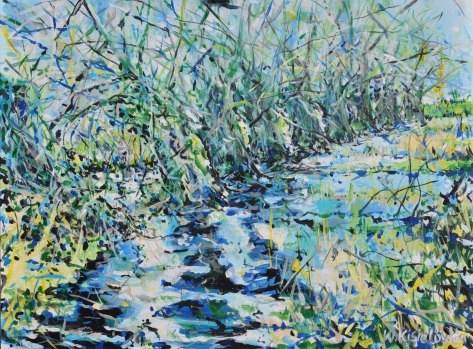 I then went onto something different and change from acrylic to gouache on board and tried a different mood using a completely different palette of colours. For me this was a way to show the same theme but in a more abstract way.
I then went onto something different and change from acrylic to gouache on board and tried a different mood using a completely different palette of colours. For me this was a way to show the same theme but in a more abstract way. The fourth piece in the series going back to acrylic I wanted to show the structure of the tree itself using darker colours including a lot of black detail. I wanted to get a more realistic form of a landscape, to show the same object in a conventional way and also try to do the same theme in a completely different style.
The fourth piece in the series going back to acrylic I wanted to show the structure of the tree itself using darker colours including a lot of black detail. I wanted to get a more realistic form of a landscape, to show the same object in a conventional way and also try to do the same theme in a completely different style.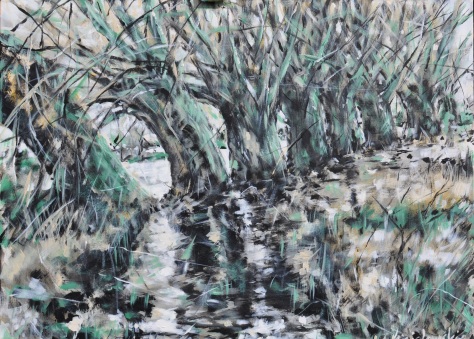 The last picture in the series is a more abstract and expressive form of the theme. While working on this piece after painting the first sketch layer of paint I added some paint brush hair in some areas, gluing it to the canvas using impasto gel, I didn’t wait till the gel dried but started the next layer of paint straight away so the hair still moved under the brush strokes. This was a very interesting experience as this created a barrier for my paintbrush and a natural relief was created which I then covered in paint. In some sense I felt like I didn’t have complete control over what happened but this created an element of randomness which after drying gave me a form of what to paint next, which was to go over the relief and between it. First idea was to recreate the same painting in this but after seeing the effect I decided to minimalize the sharpness of the trees and worked with a paintbrush to show just the branches and the light between them covering the rest of the trees showing them as less important. I would call this an attempt to create an abstraction with a theme suggestion in the background showing that there is something natural in it.
The last picture in the series is a more abstract and expressive form of the theme. While working on this piece after painting the first sketch layer of paint I added some paint brush hair in some areas, gluing it to the canvas using impasto gel, I didn’t wait till the gel dried but started the next layer of paint straight away so the hair still moved under the brush strokes. This was a very interesting experience as this created a barrier for my paintbrush and a natural relief was created which I then covered in paint. In some sense I felt like I didn’t have complete control over what happened but this created an element of randomness which after drying gave me a form of what to paint next, which was to go over the relief and between it. First idea was to recreate the same painting in this but after seeing the effect I decided to minimalize the sharpness of the trees and worked with a paintbrush to show just the branches and the light between them covering the rest of the trees showing them as less important. I would call this an attempt to create an abstraction with a theme suggestion in the background showing that there is something natural in it. The whole series of paintings has the same theme; I deliberately didn’t copy the same shape of trees because I wanted each painting to be different so I explored each one in a different way.
The whole series of paintings has the same theme; I deliberately didn’t copy the same shape of trees because I wanted each painting to be different so I explored each one in a different way.

















 I got the same problem with man-made forms. I chose simple objects like a brush on a table covered with a blue sheet covered in paint marks. I tried to arrange a few simple compositions so that I wasn’t paying attention to the detail of the brushes but to show them as objects in space, this was my only idea of showing an abstract illusion.
I got the same problem with man-made forms. I chose simple objects like a brush on a table covered with a blue sheet covered in paint marks. I tried to arrange a few simple compositions so that I wasn’t paying attention to the detail of the brushes but to show them as objects in space, this was my only idea of showing an abstract illusion.




